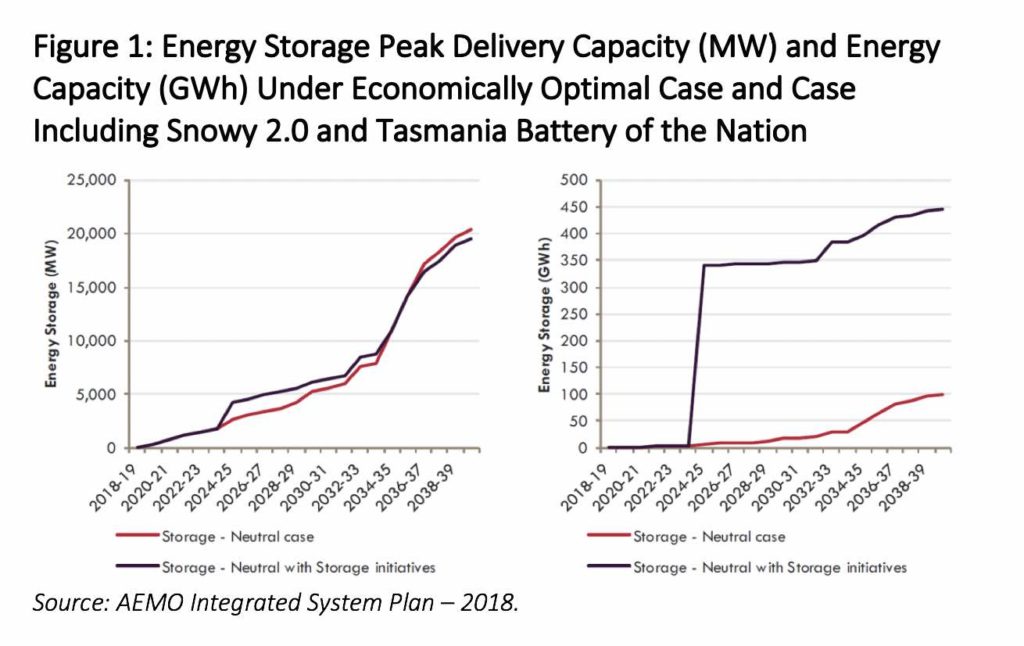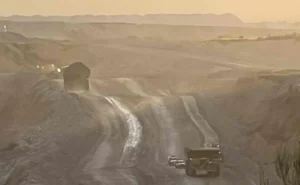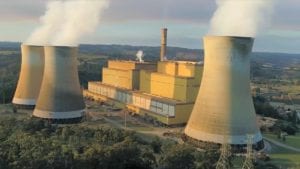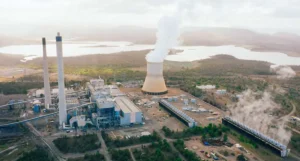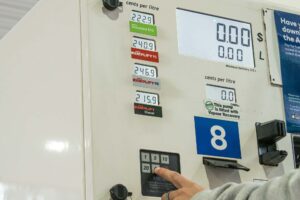“Dunkelflaute:” Where is the evidence?
The Energy Security Board has cited periods of scarce wind and solar resources as a key reason to implement the contested capacity mechanism, which will see payments from energy consumers to primarily conventional power generators for their capacity to generate electricity, rather than for actually generating electricity.
The ESB has claimed the market is not set up to incentivise installation of new technologies to provide energy in periods of scarcity.
Dr Kerry Schott, the chair of the ESB, released an opinion piece on October 6 expressing concern that the market cannot cope with winter periods with low solar and low wind resources, referred to as “dark still winter” or “Dunkelflaute”, which Dr Schott states “can last for weeks”.
Dr Schott and the ESB believe that the market is not set up to incentivise long duration resources to be installed to fill such a supply gap and thus a capacity mechanism is needed. “In my personal view it is the long-duration Dunkelflaute that really needs a capacity mechanism,” Schott stated.
One questions how and when this concern has arisen.
Throughout the entire two years of the ESB Post 2025 Market Design Process — which eventually recommended a capacity mechanism (among other proposals) – “wind drought” was barely mentioned as an area of concern.
The modelling for Dunkelflaute does not exist
No modelling has been released to quantify how big this potential “Dunkelflaute” could be or how long it could last.
In this case, modelling using historical weather data could be extremely useful. The Bureau of Meteorology has extensive data on both wind speeds and solar radiation to help evaluate the frequency and severity of Dunkelflaute events.
Such data could assist in determining both the extent to which this is a genuine problem and our best options to deal with it. Technological solutions could be quite diverse and so might be the policy mechanisms to support them.
Obvious solutions include keeping coal, gas, batteries and other dispatchable resources ready in reserve or building big pumped hydro installations.
Alternatively, the risk of Dunkelflaute could be substantially mitigated through greater wind capacity in Queensland (with transmission south). Wind generation in Queensland tends to be driven by different weather patterns to current wind farms, which are predominantly located in southern Australia.
Even more left field is that the best option might not even be power plants, but instead better insulating homes to reduce their need for energy for heating during winter.
Modelling from the Australian Energy Market Operator suggests we can shut down most of our coal capacity with only modest additions of long-duration energy storage.
The 2018 Integrated System Plan looked at two energy storage alternatives – one based on least cost, the other forcing-in the Snowy 2.0 and Tasmania’s Battery of the Nation pumped hydro installations.
This sensitivity analysis looked at a scenario where renewables reached 75% of supply and 14,000 megawatts (MW) of coal was shut.
The average duration of energy stored per megawatt of capacity in the least cost sensitivity was 5 hours (20,000MW of peak storage capacity and 100GWh of energy storage per neutral case below). This shows that shorter duration resources are more important than long duration.
Adding Snowy 2.0 and Battery of the Nation would deliver energy storage vastly in excess of what the least cost path suggested was necessary.
AEMO’s 2020 version of the Integrated System Plan under its rapid decarbonisation scenario (Step Change) shows no need for any significant additional deep storage (24 hours or longer) beyond Snowy 2.0 (red line from 2025) until 2035. Medium duration storage capacity required (4-12 hours) is also quite modest up until 2032 at less than 2500MW.
In the same timeframe, a very large amount of fossil fuel capacity, approximately 26,000MW, is shut. In this scenario, renewables reach 63% of supply in 2030 and rise to 96% by the end of the projection in 2042.
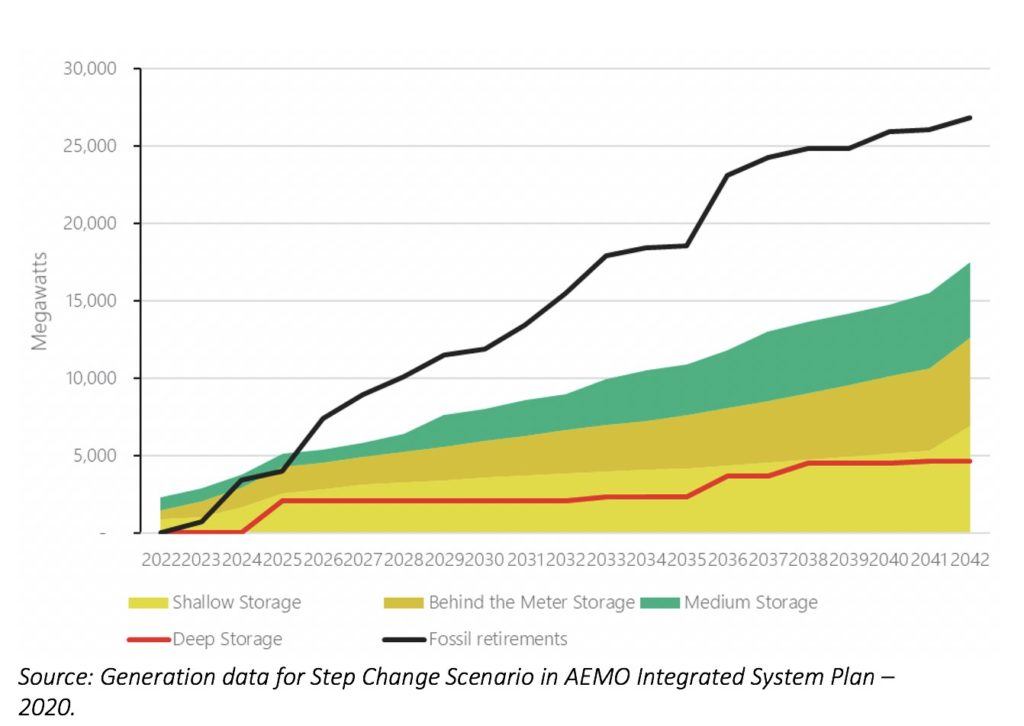
AEMO’s modelling indicates that in a high renewables grid, shorter duration storage resources are the key need, to fill gaps which are hours long, rather than long duration resources to fill gaps which are days long.
This analysis also appears to suggest that long duration storage requirements will be satisfied by projects the Federal Government and NSW Government have already committed to building.
The Federal Government has given unambiguous commitments to build not just Snowy 2.0 but also Tasmania’s Battery of the Nation. Meanwhile the NSW Government’s Electricity Infrastructure Roadmap will underwrite a further 2000MW of long duration storage.
Given this information, it is unclear as to why the ESB states that “it is the long-duration Dunkelflaute that really needs a capacity mechanism”.
If AEMO’s modelling takes into account historical weather data over numerous years, it should be possible to use the data to quantify the potential “long-duration Dunkelflaute” issue, making sure to explore extreme weather and system events, to better inform this discussion.
The ESB proposes a whole capacity market for the NEM, which could cost consumers billions of dollars per year, to solve a potential future Dunkelflaute issue that its previous papers have barely discussed, let alone quantified.
Instead of proposing a capacity payment to all fossil fuel and hydro generators every year in perpetuity, without quantifying the size and nature of the problem, the ESB should instead model if and when the “Dunkelflaute” could arise (at what penetration of renewables, which year, which season, and how long it would be), then design a mechanism accordingly.
Other non-capacity market mechanisms could also be considered such as operating reserves, strategic reserves, or even an upgrade of housing insulation standards, among others.
An informed discussion is needed.
We call on the ESB and Dr Schott to reveal the modelling supporting their view that “Dunkelflaute” will be an issue (if it exists), and reasoning for why a capacity mechanism is the best means of combatting “Dunkelflaute”.
The current process is backward. At this point in time the ESB recommendations were supposed to be finalised. The ESB has already asked for ministerial sign-off on the capacity mechanism proposal. Only now, at the 11th hour, a new concept is brought up as the key case for change for a capacity market, without reasoning or quantification. This is not best practice public policy.
By Johanna Bowyer, electricity analyst with the Institute for Energy Economics and Financial Analysis (IEEFA) and Tristan Edis, Director, Green Energy Markets.


